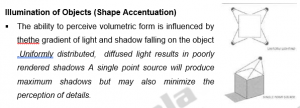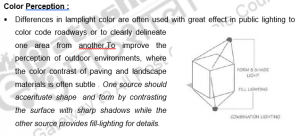26 Lighting of Public Places – 1
E-text & learn more e-Text
Lighting of Public Spaces
Lighting of public space:
- During daytime, natural light facilitates a safe, comfortable, efficient and enjoyable walking experience. During darkness, artificial lighting techniques should light the environment for the particular needs and preferences of pedestrians to maintain that standard of walking experience.
Public lighting for pedestrian areas
- Effective pedestrian lighting optimizes the amount of useable visibility that is provided. Useable visibility relates to the pedestrian behaviors that are intended and desired for an area or route – it is the nature of those pedestrian activities and locations that should drive determination of the appropriate size, location and intensity of pedestrian lighting. A light which illuminates pedestrians or pedestrian facilities is called pedestrian lighting.
- Three types of pedestrian lighting,
- Primary- takes care of all lighting tasks/only lighting (way finding, security hazards)
- Supplementary- part of larger lighting system/focused lighting( way finding, lighting possible hazards)
- Decorative- Aesthetic purposes.
- Three main factors by which Public lighting in Pedestrian areas can be controlled.
- The angle
- The distance
- The ‘size’ of t he light source
1. The angle between the light source and the viewer

2. The distance between the light source and the lit subject


Coloured lighting :
Colour appearance- Refers to the apparent colour of the emitted light. The colour appearance of lighting can be selected to particularly complement the scene being lit, to create prestigious and attractive effects .
Colour rendering- Refers to the effect that lighting has on the colours of the objects that it illuminates.
Nuisance of light- through misdirection of illumination creating glare or ‘spill’ light. ‘inappropriate lighting’ through over-lighting a location or certain features. Glare occurs when light is seen as too bright, relative to the ambient brightness that the viewer has adapted to, eg when the pedestrian moves rapidly between an area of low luminance and an area of high luminance; ‘Spill light’ occurs where illumination is provided outside of the target area. Illumination can also spill upwards, creating ‘sky glow’.
Objectives of outdoor lighting
- Improving the legibility of critical nodes, landmarks, circulations and activity zones in landscapes. Safe movement of pedestrian. Reveal salient features of site at a desired intensity of light
Outdoor lighting design principles
1. Orientation
- Lighting Hierarchy: Major and minor roads and paths are differentiated. Done by varying height, spacing, color of the lamps, distribution and brightness of the light.
- Clear Lighting Patterns –Staggered layout of road and pathway lighting tends to obscure rather than reinforce the direction of circulation and the location of intersections.
2. Identification
- Intersection Articulation – Decision points, crossings, arrival points – presence, shape and nature.
- Placement of Luminaires- Spacing height and distribution patterns.
- Deciding what to light

Deciding What to Light and what not to light
3. Safety
- Glare-Visual discomfort. Luminaries location, mounting height, fixture type and lamp intensity should be carefully selected to optimize light distribution and minimize glare.
- Under lighting- Less lighting is hazardous to protect pedestrians and public open spaces.
4. Security
- Walkway Lights – Enough peripheral distribution to immediate surroundings. Vertical light distribution over walk way areas.
5. Atmosphere and Character
- Background- Exterior spaces should have a well-defined sense of background. Should be accommodated with peripheral lighting from the walkways, signage, entrances, and other elements relevant to the definition of the space .
- Foreground-Foreground spaces should utilize local lighting which produces maximum focus, minimum distractions, and no glare.
- Surveillance – Light backgrounds. Highlight the entrances.
- Vandalism

